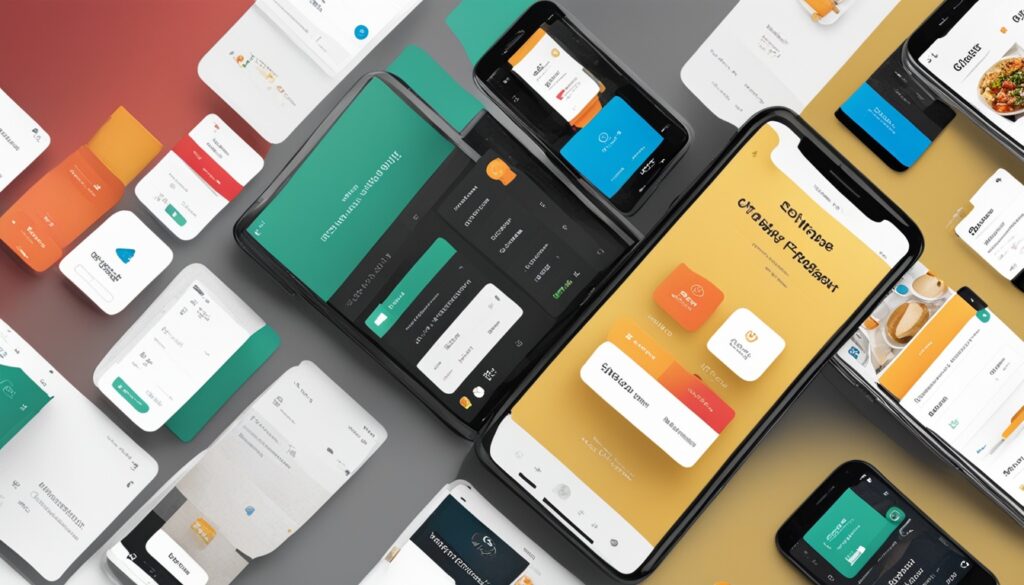The way we shop and do business has changed a lot thanks to e-commerce. Giants like Amazon are getting bigger, making us all want more user-friendly online stores. Now, businesses can make their own apps like Amazon, meeting the needs of today’s shoppers.
This guide will show you how to make your own e-commerce app. You’ll learn everything you need to know to build a successful online store. We’ll cover the basics of e-commerce, the latest tech, and design tips for an Amazon-like app.
Table of Contents
Key Takeaways
- Learn about the e-commerce world and how big names like Amazon affect it.
- Find out what features your Amazon-style e-commerce app needs.
- Discover the tech and design tips for a user-friendly, growing e-commerce platform.
- See how to manage products, shopping carts, payments, and shipping.
- Understand why secure login and permission systems are key.
Introduction to E-commerce App Development
The digital world is changing fast, making e-commerce a big deal for shopping and selling. E-commerce app development is booming, thanks to the need for smooth online shopping. It’s key for businesses to know this market well if they want to make their own e-commerce apps.
Understanding the Scope and Potential of E-commerce
Online shopping has grown a lot in the last ten years. By 2024, global online sales could hit $6.3 trillion. This growth is thanks to the ease, reach, and tailored experiences e-commerce gives shoppers. As more people shop online, the need for apps with lots of features keeps growing. This opens up big chances for businesses to use e-commerce app development trends.
The Rise of Amazon and Its Impact on Online Shopping
Amazon leads the e-commerce revolution. It focuses on making customers happy, uses new tech, and has a huge logistics network. This has made Amazon the top name in online shopping growth. Other businesses must aim high to compete with Amazon’s e-commerce dominance. By learning from Amazon’s success, businesses can understand the future of e-commerce platforms and make their own strong e-commerce apps.
“The future of retail is e-commerce, and the future of e-commerce is mobile.”
Creating an E-commerce App Like Amazon
Building an e-commerce app with Amazon-style features is a smart move for businesses. It lets you tap into the growing online market. By using the same features that make Amazon successful, you can make a strong and easy-to-use app. This app meets the needs of today’s shoppers.
At the heart of an Amazon-style app are e-commerce app features that make shopping better and increase sales. These include easy product search, smooth shopping cart, and checkout processes. These are key to making an online marketplace stand out in the market.
| E-commerce App Feature | Importance |
|---|---|
| Comprehensive Product Catalog | Offer a wide selection of products to cater to diverse customer preferences. |
| Advanced Search and Filtering | Enable customers to quickly find the products they’re looking for. |
| Personalized Recommendations | Suggest relevant products based on customer browsing and purchase history. |
| Secure Payment Gateway | Provide a seamless and trustworthy checkout experience. |
| Order Tracking and Management | Offer customers visibility and control over their orders. |
With these key features, you can make an Amazon-style e-commerce platform. This platform offers a better shopping experience. It also sets your business up for success in the competitive online market.
To make a successful e-commerce app, focus on the key functionalities that made Amazon a leader. Then, add these elements to your building online marketplace project. With a smart approach, you can make an app that attracts your audience. It also helps your business grow in the e-commerce world.
Choosing the Right Tech Stack
Choosing the right e-commerce app technology stack is key to a strong and growing e-commerce platform. For frontend development for e-commerce, top picks are React, Angular, and Vue.js. These offer great tools for making user interfaces dynamic and responsive. For the backend frameworks for online marketplaces, Node.js, Ruby on Rails, and Django are great. They handle complex tasks, API work, and data management well.
Frontend Technologies for E-commerce Apps
The frontend is what users see and interact with. Using the best frontend technologies can make the user experience better and keep customers coming back. Top choices for e-commerce include:
- React: A JavaScript library known for its efficient rendering and component-based architecture, making it an excellent choice for building scalable and dynamic e-commerce interfaces.
- Angular: A comprehensive framework that provides a structured approach to building complex web applications, including robust features for e-commerce functionalities.
- Vue.js: A progressive framework that is lightweight, easy to learn, and well-suited for creating modern, responsive, and interactive e-commerce user interfaces.
Backend Frameworks and Databases for E-commerce
The backend handles server-side logic, data, and service integrations. For backend frameworks for online marketplaces, here are some top picks:
- Node.js: A runtime environment that lets JavaScript run on the server, offering a strong base for scalable e-commerce apps.
- Ruby on Rails: A web framework that boosts developer productivity and uses the Model-View-Controller (MVC) pattern, ideal for e-commerce.
- Django: A Python web framework that eases complex web app development, including e-commerce, with its many features and tools.
For database solutions for e-commerce, you can use relational databases like MySQL, PostgreSQL, or NoSQL databases like MongoDB and Couchbase. The choice depends on your app’s needs.
“The right technology stack can make or break the success of your e-commerce app. Carefully evaluate your requirements and choose the tools that will best support your business goals.”
Building the User Interface
The user interface (UI) and user experience (UX) are key to a successful e-commerce app. Designing an intuitive and engaging UI is vital. It should match the Amazon user experience. By using Amazon-inspired UI elements and following user experience principles for online marketplaces, you can make an e-commerce app UI design that grabs and pleases users.
Embracing the Amazon UX Approach
Amazon leads in e-commerce UI and UX, offering valuable lessons. Aim for a clean, simple layout that makes finding and buying products easy. Use clear navigation, easy calls-to-action, and a smooth checkout to help users shop easily.
- Adopt a minimalist, mobile-friendly design that highlights your products
- Implement intuitive navigation and search functionality to help users find what they need
- Streamline the checkout process to minimize friction and abandoned carts
- Incorporate personalized product recommendations to enhance the e-commerce app usability
By focusing on user experience principles for online marketplaces, you can craft an e-commerce app UI design that offers a smooth, engaging shopping experience for your customers.
“The key to success in e-commerce is providing a user experience that is as intuitive and frictionless as possible.” – Jeff Bezos, Founder of Amazon
Implementing E-commerce Functionalities
Creating an e-commerce app like Amazon needs a strong set of features. These include easy product browsing, managing shopping carts, checking out, and fulfilling orders. These essential e-commerce functionalities make sure users have a smooth shopping experience.
The product catalog is key in any core e-commerce app features. Customers should easily find a wide range of products. They should see detailed descriptions, high-quality images, and reviews to help them decide. Features like advanced search and filtering, similar to Amazon-like app capabilities, help users find products fast.
The shopping cart and checkout are crucial for a good user experience. Customers want a smooth checkout with options to save their cart, use coupons, and pick payment methods. A reliable payment gateway is key for secure transactions and building trust with customers.
| Core E-commerce Functionalities | Key Features |
|---|---|
| Product Catalog Management |
|
| Shopping Cart and Checkout |
|
| Order Management and Fulfillment |
|
A strong order management and fulfillment system is key. It makes sure customers get their orders fast and reliably. This includes tracking orders, working with shipping providers, and managing inventory well. By using these core e-commerce app features and essential e-commerce functionalities, you can create an Amazon-like app capabilities. This gives your users a top-notch e-commerce experience.
Product Catalog and Inventory Management
Having a great e-commerce product catalog and managing your inventory well is key for success online. By looking at leaders like Amazon, businesses can make their product pages easy to use and fun. This helps customers engage more and buy more.
Organizing and Displaying Products
When you’re setting up your e-commerce product catalog, think about a few key things. Put products into clear categories, just like Amazon does. This makes it easy for customers to find what they need. Also, add detailed descriptions, good images, and customer reviews to make your products stand out.
- Categorize products based on logical groupings and customer behavior
- Provide comprehensive product details, including descriptions, specifications, and dimensions
- Showcase high-resolution images from multiple angles to showcase product features
- Leverage customer reviews and ratings to build trust and credibility
Managing your inventory for online marketplaces well is also key for a smooth shopping experience. Linking your e-commerce product catalog with real-time inventory updates makes sure customers only see what’s available. This reduces the chance of selling out or letting customers down.
By taking cues from Amazon-inspired product pages and using these tips, businesses can make a strong, easy-to-use product catalog. This makes the e-commerce shopping experience better for everyone.
Shopping Cart and Checkout Process
In the world of e-commerce, the shopping cart and checkout process are key to success. They help turn browsers into buyers. Making these steps easy and friendly can make all the difference. By learning from leaders like Amazon, you can make your app stand out.
Using an Amazon-style cart and checkout can improve your app. It makes shopping smoother and can lead to more sales. A simple checkout process helps users buy easily, which means more happy customers.
Key Elements of a User-Friendly Checkout Experience
- Clear and intuitive shopping cart display, allowing users to easily review their selected items
- Straightforward checkout flow, guiding customers through the payment and order review steps
- Secure and reliable payment gateway integration, ensuring a seamless and trustworthy transaction
- Responsive and mobile-optimized design, catering to the growing preference for on-the-go shopping
- Guest checkout option, eliminating unnecessary account creation barriers
- Saved payment and shipping information, enhancing the convenience for returning customers
Adding these features to your app makes shopping easy and fun. It builds loyalty and helps your business grow.
| Feature | Benefits |
|---|---|
| Intuitive Cart Display | Enables customers to easily review and manage their selected items |
| Streamlined Checkout Flow | Guides users through the payment and order review steps efficiently |
| Secure Payment Integration | Builds customer trust and confidence in the transaction process |
| Mobile Optimization | Caters to the growing preference for on-the-go shopping experiences |
| Guest Checkout Option | Removes unnecessary account creation barriers, increasing conversion rates |
| Saved User Information | Enhances convenience and streamlines the checkout experience for returning customers |
Focus on making your app’s shopping cart and checkout easy and friendly. This approach will boost customer satisfaction and loyalty. It will also increase your sales and revenue.
“A well-designed shopping cart and checkout process can make or break an e-commerce business. It’s the final step in the customer journey, and it needs to be seamless and intuitive.”
Payment Gateway Integration
For any e-commerce app, having a reliable and secure payment gateway is key. It’s important to make sure customers have a smooth and safe way to pay. This is why payment gateway integration is so important for your app’s success.
Secure Payment Processing Options
When picking a payment gateway, security is a top concern. E-commerce apps need to keep customer data safe, especially financial info. This builds trust and follows industry rules. Here are some secure payment options for e-commerce apps:
- e-commerce payment gateway integration with big names like PayPal, Stripe, and Amazon Pay
- secure payment processing for online marketplaces with things like tokenization and full encryption
- Amazon payment methods that use the trusted Amazon name and make checking out easy for customers
- PCI compliance for e-commerce apps for top data security and fraud protection
| Payment Gateway | Features | PCI Compliance |
|---|---|---|
| PayPal | Strong fraud protection, easy mobile checkout, and smooth integration | PCI DSS Level 1 certified |
| Stripe | Top-notch security, customizable checkout, and support for many currencies | PCI DSS Level 1 certified |
| Amazon Pay | Uses Amazon’s trust and fast checkout, easy to add to your app | PCI DSS Level 1 certified |
Choosing and adding a secure payment gateway helps e-commerce app makers give customers a safe and easy way to pay. This leads to more sales and happy customers.
Order Management and Fulfillment
In the world of e-commerce, order management and fulfillment are key to a smooth shopping experience. Like Amazon, e-commerce app developers need to excel in e-commerce order management. They must handle order fulfillment and track orders like Amazon does.
Good e-commerce order management is vital for an app’s success. It covers the order’s life from start to finish. Having strong order tracking, like Amazon’s, keeps customers updated. This builds trust and loyalty.
For e-commerce apps, making logistics and shipping efficient is key. Adding real-time shipping updates and various shipping options can make your app stand out.
| Key Order Management and Fulfillment Strategies | Benefits |
|---|---|
| Automated order processing and tracking | Streamlined workflow, improved efficiency, and enhanced customer visibility |
| Flexible shipping options and delivery estimates | Increased customer satisfaction and loyalty |
| Seamless integration with logistics providers | Efficient order fulfillment and reliable delivery |
Mastering e-commerce order management and order fulfillment for online marketplaces lets developers create a top-notch experience. This keeps customers coming back.
“Effective order management and fulfillment are the unsung heroes of e-commerce, ensuring a seamless and satisfying customer experience.”
User Authentication and Authorization
In the world of online shopping, making sure users are safe and secure is key. E-commerce apps aim to be like big names like Amazon. They focus on easy yet safe ways to log in and sign up.
Implementing Secure Login and Registration
Keeping customer data safe is crucial in online shopping. E-commerce user authentication is a big part of this. By using Amazon’s methods, secure user registration and Amazon-inspired account management can be made better with best practices.
Using multi-factor authentication is a good idea. This means users need more than just a username and password. Options like SMS codes, biometric scans, or security keys can be used. These secure user registration steps help keep customer data safe and build trust.
Also, making account management easy, like Amazon does, makes things better for users. Options for resetting passwords, updating info, and recovering accounts give users control over their Amazon-inspired account management.
By focusing on safe login and sign-up, e-commerce apps can create a trustworthy place. This makes customers feel safe with their e-commerce user authentication and the protection of customer data in e-commerce apps.
Search and Filtering Capabilities
Having great search and filtering features is key for helping customers find products in your e-commerce app. It’s like the smooth experience you get at places like Amazon. We’ll look into ways to make your app’s search and filtering better. This will make it easier for users to find what they need.
Navigating the Product Catalog
It’s important to give customers easy ways to search and filter products. This makes it easier for them to find what they want in your online store. By letting users quickly go through your products, you make shopping better and help them buy more.
- Use a strong search engine that lets customers search with everyday language and important keywords.
- Give advanced product filtering tools so users can narrow down their search by price, brand, color, size, and more.
- Make sure the filters are easy to see and change, so customers can adjust their search easily.
Designing Engaging Discovery Experiences
There’s more to search and filtering than just the basics. Think about adding Amazon-style product search and discovery features to grab your customers’ attention and encourage them to explore more.
- Use machine learning and personalization to show products that match what users like and do.
- Try out interactive ways to browse products, like visual sorting or faceted navigation, to help customers find new and interesting items.
- Keep making your search and filtering better based on what users say and data to improve the product discovery process.
By focusing on easy search and advanced filtering, you help your customers easily find what they want in your e-commerce app. This leads to more engagement, more sales, and happier customers.
“Effective search and filtering are the keys to unlocking a seamless product discovery experience for your customers.”
Testing and Deployment
Creating an e-commerce app like Amazon needs careful testing and a solid deployment plan. This ensures it does well over time. By learning from Amazon’s focus on quality and performance, you can make an app that meets user needs and grows easily.
Comprehensive E-commerce App Testing
Testing is key to finding and fixing problems before your app is out. Use a detailed testing plan that includes:
- Unit testing to check each app part
- Integration testing for smooth module interactions
- End-to-end testing to mimic real user actions
- Performance testing to see how it handles more users
- Security testing to protect user data and transactions
Deployment Best Practices
When deploying your app, follow Amazon’s careful steps. Use a staged deployment to slowly add updates and features, reducing the chance of problems. Choose cloud-based hosting and containerization to make sure your app is reliable and can grow.
| Amazon’s Approach | Your E-commerce App |
|---|---|
| Rigorous testing and quality assurance | Comprehensive testing strategies to identify and resolve issues |
| Gradual, controlled deployment of updates | Staged deployment to minimize disruptions and ensure a smooth user experience |
| Scalable, cloud-based infrastructure | Leveraging cloud technologies and containerization for reliable app hosting |
By focusing on e-commerce app testing and using deployment best practices, you can make sure your online marketplace is scalable and successful. This will give users an experience as good as Amazon’s.
Conclusion
As we wrap up our look at e-commerce app development, it’s clear that success comes from knowing the industry well and using a smart strategy. This includes understanding the market, using the right technology, and focusing on user experience and key features.
We’ve looked at what makes e-commerce giants like Amazon successful. This includes having a strong tech base and a user-friendly interface. It also means having smooth payment and order systems. By following these steps and always innovating, businesses can lead in the growing e-commerce world.
The future of making e-commerce apps is both thrilling and tough. As shoppers want more and new tech comes out, making apps that focus on users and give a great shopping experience is key. By being ahead, using data to make decisions, and putting customers first, businesses can grab the big opportunities in e-commerce. They can become top players in the digital market.














